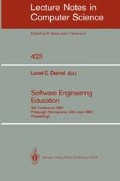Abstract
The book Concurrent Program Structures, published in 1988 [1], was based on a course, Concurrent Systems, introduced at Queen's University, Belfast in 1981. The purpose of this paper is to examine the successful and less successful aspects of that course, with a view to making improvements to the material presented. A revised edition of Concurrent Program Structures is planned.
Preview
Unable to display preview. Download preview PDF.
References
Bustard, D.W., Elder, J.W.G. and Welsh, J.: Concurrent Program Structures, Prentice Hall International, 1988
Parnas, D.L., On the criteria to be used in decomposing systems into modules, CACM, Vol. 15, pp 1053–1058, 1972; reprinted in Freeman, P. and Wasermann, A.I., Tutorial on Software Design Techniques, 4th edn., IEEE, 1983
Welsh, J. and Bustard, D.W., Pascal Plus: another language for modular multiprogramming, Software Practice and Experience, Vol.9, pp 947–957, 1979
Holt, R.C., Concurrent Euclid, the UNIX system and TUNIS, Addison Wesley, 1983
Brinch Hansen, P., The Architecture of Concurrent Programs, Prentice Hall, 1977
Watt, D.A., Wichmann, B.A. and Findlay, W., Ada Language and Methodology, Prentice Hall, 1987
Wirth N, Programming in Modula-2 (3rd edn), Springer Verlag, Berlin, 1985
Hoare, C.A.R.: Communicating Sequential Processes, Prentice Hall International, 1985
Milner, R.: Communication and Concurrency, Prentice Hall International, 1989
Inmos Ltd, occam Programming Manual, Prentice Hall International, 1984
Brinksma, E. (Ed.): Information processing systems — Open systems interconnection — LOTOS — A Formal Technique Based on the Temporal Ordering of Observational Behaviour, ISO DIS 8807, Jul. 1987
Bustard D.W., Norris M.T. & Orr R.A.,: Formalising the Design of Ada Systems using LOTOS, Proceedings of the 1989 Ada Europe Conference, Madrid, June 1989
Reisig, W., Petri Nets: an introduction, Springer-Verlag, 1982
Patel S., Orr R.A., Norris M.T. & Bustard D.W.,: Tools to Support Formal Methods, in Proceedings of the Eleventh International Conference on Software Engineering, May 1989
Bustard, D.W.: Pascal Plus in Biased Perspective, in proceeding of the IFIP Working Conference on System Implementation Languages: Experience and Assessment, (North Holland, 1985)
Author information
Authors and Affiliations
Editor information
Rights and permissions
Copyright information
© 1990 Springer-Verlag Berlin Heidelberg
About this paper
Cite this paper
Bustard, D. (1990). An experience of teaching concurrency: Looking back, looking forward. In: Deimel, L.E. (eds) Software Engineering Education. SEI 1990. Lecture Notes in Computer Science, vol 423. Springer, New York, NY. https://doi.org/10.1007/BFb0040446
Download citation
DOI: https://doi.org/10.1007/BFb0040446
Published:
Publisher Name: Springer, New York, NY
Print ISBN: 978-0-387-97274-9
Online ISBN: 978-0-387-34802-5
eBook Packages: Springer Book Archive

